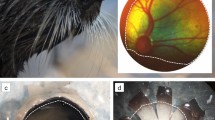Abstract
AMPHIBIOUS vision for all animals with curved corneas requires an exceptional range of focusing ability. Whereas the cornea in air focuses light like a strong positive lens, under water it becomes a very weak positive lens because it has approximately the same refractive index as water. Thus, land animals become hypermetropic (far-sighted) in water and aquatic animals become myopic (near-sighted) in air. In some fish, this gain or loss of lens power amounts to as much as 20 to 30 dioptres1.
Similar content being viewed by others
References
Baylor, E. R., and Shaw, E., Science, 136, 157 (1962).
Walls, G., The vertebrate Eye (Cranbrook Inst. of Science, Bloomfield Hills, Michigan, 1942).
Davson, H., The Physiology of the Eye (Blakiston, Philadelphia, 1950).
Rochon-Duvigneaud, A., Les Yeux et la Vision des Vertébrés (Massson et Cie, Paris, 1943).
Verrier, M. L., Bull. Soc. Zool. France, 59, 535 (1934).
Verrier, M. L., Ann. Biol. Paris, Ser. 3, 24, 209 (1948).
Barron, J., and Verrier, M. L., Bull. Biol. France Belg., 85, 105 (1951).
Author information
Authors and Affiliations
Rights and permissions
About this article
Cite this article
BAYLOR, E. Air and Water Vision of the Atlantic Flying Fish, Cypselurus heterurus. Nature 214, 307–309 (1967). https://doi.org/10.1038/214307a0
Issue Date:
DOI: https://doi.org/10.1038/214307a0
- Springer Nature Limited
This article is cited by
-
How and why do flying fish fly?
Reviews in Fish Biology and Fisheries (1994)
-
Amphibious vision inCoryphoblennius galerita L. (Perciformes)
Experientia (1992)
-
Metabolism and route of excretion of the chloro-cyclodiene HCE in the pigeon
Archives of Environmental Contamination and Toxicology (1981)
-
Ein septum papillaris im auge von Pantodon buchholzi pet. (Teleostei, Osteoglossiformes)
Zeitschrift für Morphologie der Tiere (1971)





